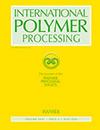多层共挤吹塑成型
IF 1.9
4区 工程技术
Q4 ENGINEERING, CHEMICAL
引用次数: 0
摘要
摘要 通过层倍增技术和吹塑装置进行多层共挤,生产出具有 129 层聚苯乙烯(PS)和聚甲基丙烯酸甲酯(PMMA)交替层模型系统结构的瓶子。这种方法显示了在挤压过程中利用熔体旋转进行层保持和厚度控制的效果。以不同的旋转速度对样品进行挤压和角变形,然后吹塑成瓶,并对整体壁厚和单层厚度进行分析。角度旋转会导致焊缝变形和层厚度的变化,超过临界旋转速度时,在挤压管材结构时产生的焊缝会发生适当的螺旋变形,从而在吹塑过程中产生均匀变形。这种方法对高性能(如高阻隔、绝缘和机械性能)最为重要的单腔吹塑工艺具有潜在的巨大影响,潜在的行业包括气体运输、特种包装和医疗。本文章由计算机程序翻译,如有差异,请以英文原文为准。
Multi-layer co-extrusion blow molding
Abstract Multi-layer co-extrusion via the layer multiplication technique and a blow-molding set-up were used to produce bottles with a 129-layered structure of a model system of alternating polystyrene (PS) and poly (methyl methacrylate) (PMMA) layers. This method shows layer retention and thickness control with the use of melt rotation during the extrusion process. Samples were extruded and deformed angularly at different rotation speeds, blow-molded into bottles, and the overall wall thickness and analysis of individual layer thicknesses were performed. Angular rotation leads to weld line deformation and a change in layer thickness above a critical rotation speed in which the weld lines, inherited in the extrusion of the tube structures, are suitably deformed helically leading to uniform deformation during the blowing process. This method has potentially large implications for single cavity blow molding processes where high-performance properties, e.g., high barrier, insulation, mechanical, are of upmost importance, potential industries include gas transport, specialty packaging, and medical.
求助全文
通过发布文献求助,成功后即可免费获取论文全文。
去求助
来源期刊

International Polymer Processing
工程技术-高分子科学
CiteScore
2.20
自引率
7.70%
发文量
62
审稿时长
6 months
期刊介绍:
International Polymer Processing offers original research contributions, invited review papers and recent technological developments in processing thermoplastics, thermosets, elastomers and fibers as well as polymer reaction engineering. For more than 25 years International Polymer Processing, the journal of the Polymer Processing Society, provides strictly peer-reviewed, high-quality articles and rapid communications from the leading experts around the world.
 求助内容:
求助内容: 应助结果提醒方式:
应助结果提醒方式:


